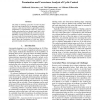Free Online Productivity Tools
i2Speak
i2Symbol
i2OCR
iTex2Img
iWeb2Print
iWeb2Shot
i2Type
iPdf2Split
iPdf2Merge
i2Bopomofo
i2Arabic
i2Style
i2Image
i2PDF
iLatex2Rtf
Sci2ools
AAAI
2011
2011
Termination and Correctness Analysis of Cyclic Control
The utility of including cyclic flow of control in plans has been long recognized by the planning community. Loops in a plan increase both its applicability and the compactness of representation. However, progress in finding such plans has been limited largely due to lack of methods for reasoning about the correctness and applicability of loops of actions. We present an overview of recent results for determining the class of problems that a plan with loops can solve. These methods can be used to direct the construction of a rich new form of generalized plans that solve a desired class of problems.
| Added | 12 Dec 2011 |
| Updated | 12 Dec 2011 |
| Type | Journal |
| Year | 2011 |
| Where | AAAI |
| Authors | Siddharth Srivastava, Neil Immerman, Shlomo Zilberstein |
Comments (0)

